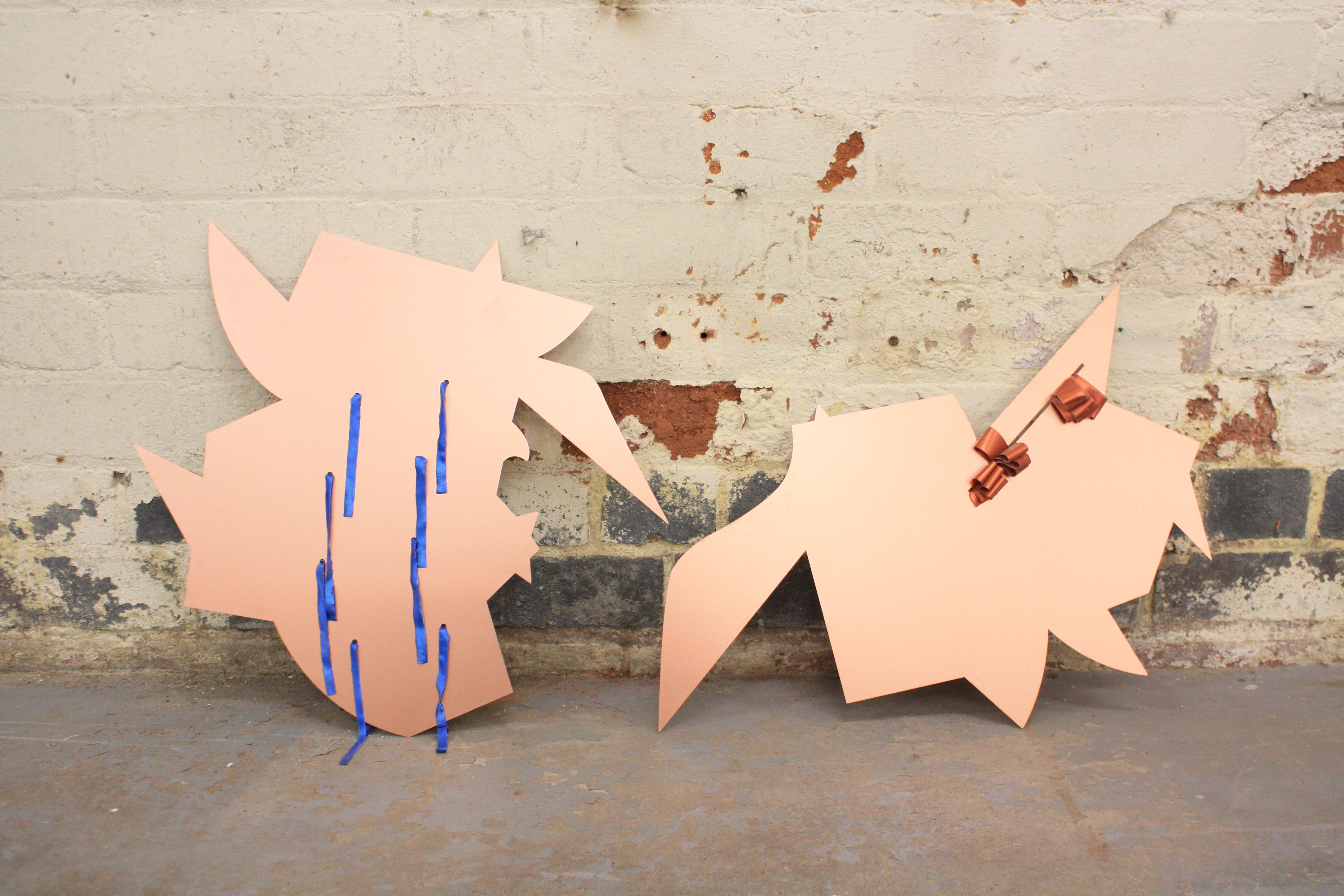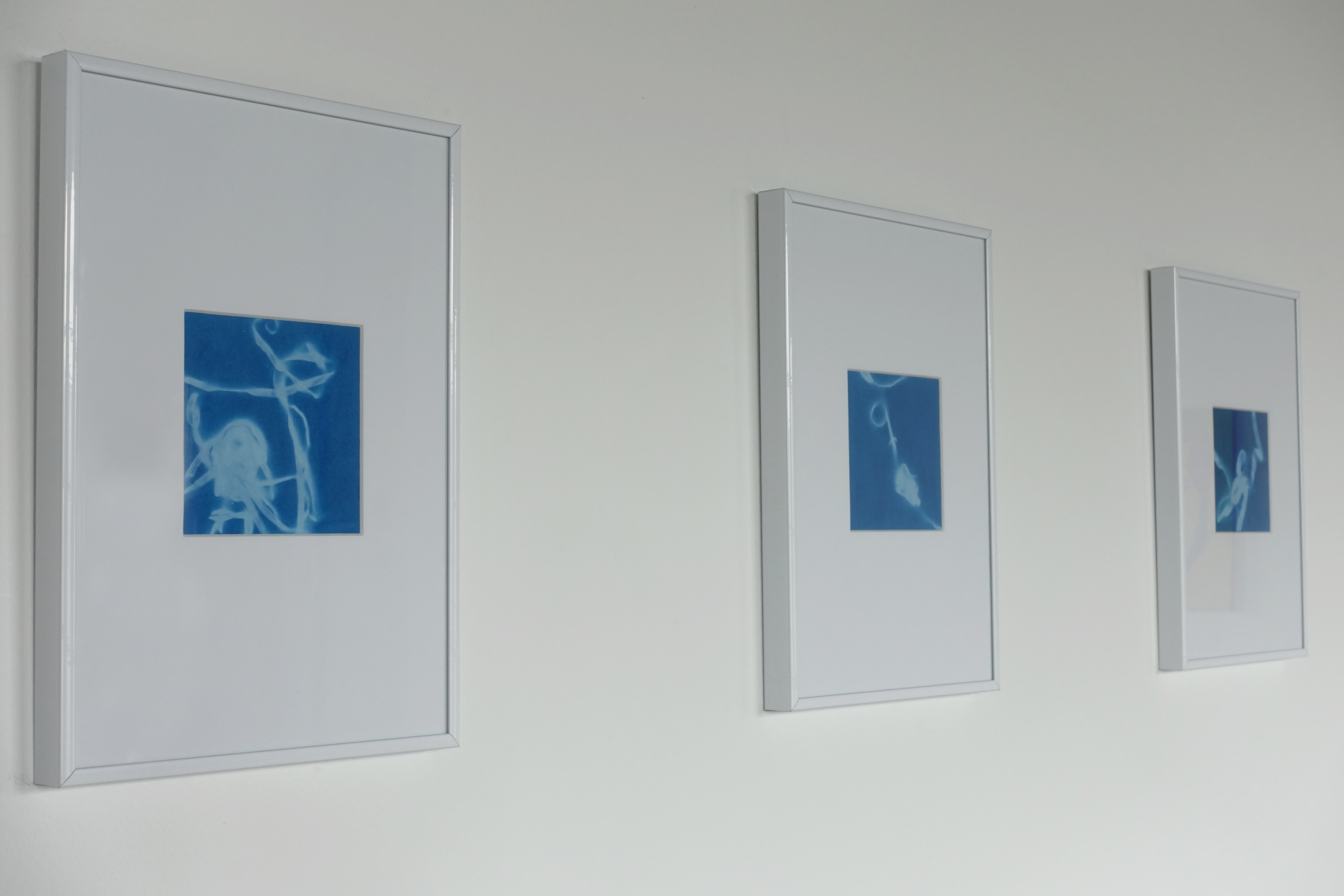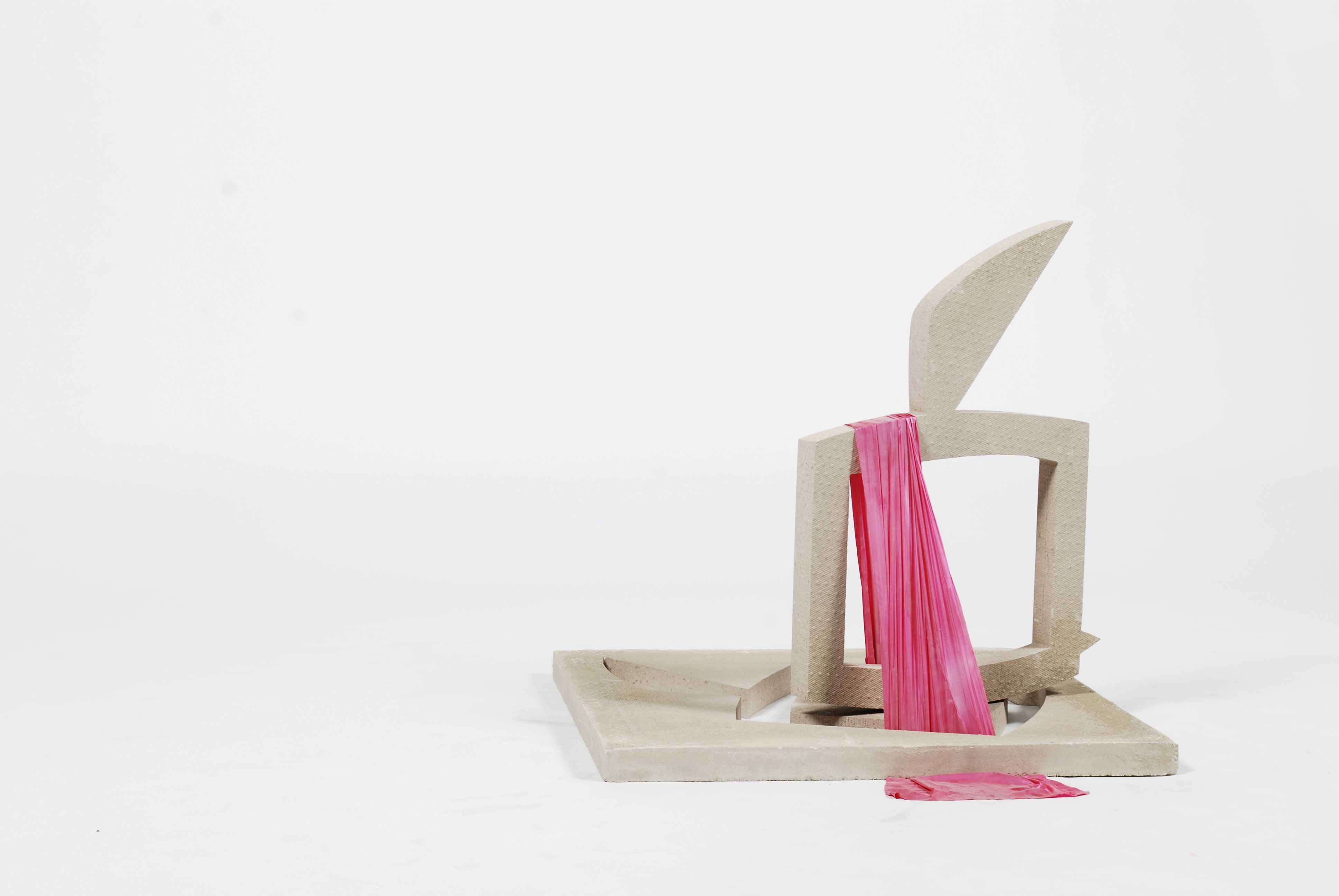Colette Griffin
Interview by Rachel Graves
-
Published September 2018
-
It seems to me that experimentation and process are really important parts of your practice. There is an ongoing conversation with your materials: it’s not only about the object itself but how it has come into being. Could you tell me about the role that studio-based practice plays in your work?
I use my studio as a device for negotiating and handling new materials. It allows me the physical and mental space to work and is a tool that shapes the way that I think.
Often people ask if I paint or sculpt and what materials I work with, I respond with a fairly long list, which at first may make my practice seem erratic. I use the materials or methods that are most appropriate to the work I want to make; mood, time and place can also play a role.
For about 2 years I was between studios (I’m now at One Thoresby Street, Nottingham) and was making work exclusively at home, so I started to explore domestic materials and began to consider the performative nature or ritualistic behaviours. You can make and maintain a practice without a studio and working from home meant that new strands of research presented themselves. For many artists, the studio is a place where they can shut out any distractions, allowing an intense focus of attention, but it is not a necessity. I think it is important to stress that.
 Where none exists (installation view), One Thoresby Street, Nottingham 2018
Where none exists (installation view), One Thoresby Street, Nottingham 2018 Past her, (part of Where none exists), One Thoresby Street, Nottingham 2018
Past her, (part of Where none exists), One Thoresby Street, Nottingham 2018Has your return to working in a studio had an impact on the work you have been making? Or have you brought the domestic into the studio with you?
It has. I had stopped making sculptures for a few years and focused solely on print and video work. I didn’t have the room to store and layout the steel shapes I now work with again, and I didn’t have the 'messy space' required for making latex. Latex is often the soft hand-crafted element in my sculptures, which sits alongside the hard, machine-made laser cut steel. I’ve recently returned to sculpture, it’s the perfect medium for exploring shape, scale and contradictions.
I certainly have brought the two together, combining domestic or routine processes and materials with those you associate with a more traditional sculptural language. For me it is an exciting pairing.
 Shape Combination 4 and 2 (copper), Two Queens, Leicester, 2012
Shape Combination 4 and 2 (copper), Two Queens, Leicester, 2012You have used pasta as a medium in a number of different works in recent years. What is it about this material that appeals to you?
Fresh pasta is unpredictable, or at least it is when I make it. Sometimes it works beautifully and is elastic and durable and glossy, other times it is thick and dry and brittle. Even though only two ingredients are used in pasta making I liken the process to baking, you can bake 10 cakes following the exact same recipe and they would all turn out slightly different.
It is also accessible, it’s cheap and it’s in your kitchen. I gave a pasta-making workshop at New College Nottingham to coincide with an exhibition of my work at what was the Lace Market Gallery. Together with a group of students we made pasta and discussed my work in the show. I wanted the students to understand that every action, every activity can be an act of creativity. Pasta, like clay or concrete or latex is a material, you handle it, you work with it, you sculpt it.
The act and outcome of pasta making are both very versatile. The act has featured in my video, Little Turnip; the material has been used as the subject in my Sunprintseries; and the object has appeared in recent sculptural works.
I’m really intrigued by your recent Sunprints, which use a simple photographic process to render 3D pasta forms into two dimensions. You have worked with a number of different printmaking techniques in the past - how do you view the relationship between your 2D and 3D work?
It’s an important relationship. I like to layer different processes when making new work. I quite often draw sculptures after I have fabricated or installed them, as well as planning them out on Illustrator or by hand before they become physical objects. It helps me to better understand the properties of a sculpture.
Sometimes the prints are sketches, a way to play with ideas for works that I may or may not realise in three-dimensions, but often when making a print I can be more creative than when producing a sculpture. I can depict a shape or composition in two-dimensions that could not physically, or easily exist in three-dimensions.
The Sunprints have a really beautiful and three-dimensional quality, due to the way the pasta falls on the paper. Some edges touch the sheet, some turn away. The process captures the way the material moves, a gesture you only really experience when handling it. I have demonstrated this quality using video, but I think the prints allow for more detail.

(left right) Stopper Knot, Nodi, Connective, cyanotype (as part of Where none exists), One Thoresby Street, Nottingham, 2018
I want to ask you about two videos that you have made recently: Exsertus(2017) and Little Turnip (2015). You appear in both and I wonder if you found that to be a different experience in comparison to your sculptural practice and printmaking?
You mentioned the ongoing conversation between myself and my materials. I made Exsertus and Little Turnip to record this conversation and highlight its importance. I hope they help to resolve my sculptural and print works too.
Both videos follow me on a journey of exploration, examining a process and the intimate relationship between myself, an action and a material.
I see the works more as performances, a record of a very natural activity or interaction. Forgetting you are being recorded is hard. If you are watched carrying out an activity you do every day, it inevitably goes wrong. I didn’t climb my best the day that Exsertuswas filmed and I didn’t make the best pasta during the recording of Little Turnip (both were filmed by artist Amy Pickles). But I didn’t want to do a second take. In life we make mistakes. Exsertus documents my efforts and failings. By only doing one take I relinquished full control over the outcome, I often try to do this. Each time I install a sculpture it is different, I remake the latex or pasta element on every occasion. When making sunprints the sun is the variable, when making Little Turnip and Exsertus, I was.
Pasta is one of the more overt links to domesticity and daily life, but I feel that there is an expanded view of creative practice that runs throughout your work. I’m thinking in particular of Joseph Beuys’ assertion that ‘everyone is an artist’ but you also find influences beyond a traditional Western view of art history?
Joseph Beuys’ methods of thinking have indeed been an influence on my own. A quote from Beuys that best sums up my current ideas is – “even the act of peeling a potato can be an artistic act if it is consciously done” (Artforum, November 1969). I welcome the notion that we are sculpting the world through everyday activities and actions.
Postmodernism has re-evaluated the domestic using two different approaches, considering it as a site of repression but also as space of rising autonomy. The later fits the ideals of my practice, expanding the definition of ‘domestic’, which already has so many interpretations. Artists in the 60s and 70s performed housework as art. In her Manifesto for Maintenance ArtMierle Laderman Ukeles states, “everything I do is Art is Art”.
Eastern views of art history have also informed my work over the last few years. Zen Buddhism places great emphasis on practical tasks such as tidying the garden and cooking. If you are just taught things you are only acquiring knowledge, but by putting them into practice you can realise these lessons. The relationship between object, figure and movement is very important to me.
 Little Turnip, Pickford's House (part of UKYA National Festival), 2016. Image by David Sever
Little Turnip, Pickford's House (part of UKYA National Festival), 2016. Image by David SeverYou are also a Creative Producer with Mansions of the Future in Lincoln, an organisation exploring a radical model of creating a shared culture within the city by bringing artists and communities together. Could you tell me a bit about the work that Mansions of the Future has been doing? Have you found that your involvement with Mansions of the Future is informing your practice as an artist?
Your outline is really accurate. The artists we work with either have socially engaged practices’ or are interested in engaging more with community and place through workshops and activities.
We opened in May, after working with our inaugural artist Kathrin Böhm to equip the space for public discussion about local culture through action. We wanted to open the space up to the city, rather than working tirelessly on presenting something that was polished. We encourage the public to take ownership over the building. Kathrin’s design proposed different functions for each room, to find out, mix and publish what’s happening culturally in Lincoln and nearby.
Kathrin’s commission is titled Culture is a Verband continues to inform our opening season. Our programme has weekly, monthly and seasonal activities; often food, drink and Communal Lunches are used as starting points to engage with groups and generate ideas. And we have just wrapped up our DIY Summer School residency, curated by Kathrin and artist Tom James.
Practical Philosopher Ayisha de Lanerolle continues to deliver philosophical enquiry sessions across a number of schools and at the MotF building. The focus is on helping participants to develop skills in articulating their own options and concerns.
We also commissioned artist Bridget Smith to create work for the public realm. Now it is Permitted combines visionary statements from artists, writers, musicians and filmmakers that offer ways of thinking about how to live in uncertain times.
In May we premiered Medusa’s Ankles, a short film by Bonnie Wright, inspired by an A.S Byatt story. Set in a hair salon the film points out the differences in the way we view ourselves and are viewed by others as we reach middle age. We installed the work at the amazing Sincil Salon, so that people could watch the film whilst hair was washed, cut and dyed around them. This was a really immersive experience. The film in now up on BBC IPlayer and stars Kerry Fox, Jason Isaacs & Chanel Cresswell.
Yes, the Mansions of the Future programme and ethos have made me think about why I work in the way that I do. I am not a socially engaged practitioner, that’s my choice and it’s not a negative, but I have certainly started to chew over the reasons why.
At the Summer School we discussed an article by Rosalie Schwieker, who I met during our Buildings for Radical Culture day. ‘More mince, less sausage’ describes the difference between mince artists and sausage artists. “Sausage artists make easily recognisable, tasty art sausages, like solo shows or performances”, whereas mince artists are versatile and harder to pin down, they “work in the engine room of the art world. They are the producers, the educators, the designers, the facilitators.” I have realised that there is a type of value in being a mince artist that you don’t get from being a sausage artist.
However, my practice is currently a solitary act, something I can do outside of my producer role. It’s important to me that I have a degree separation between the two, but both hopefully enrich each other.
 Unititled (Shape 3) (concrete), 2012
Unititled (Shape 3) (concrete), 2012What’s next for you?
I am thrilled to be participating in the UKYA City Takeover: Nottingham 2019 in February, uniting over 250 artists based in the UK, China, South Korea, Europe and the Mediterranean. I have contributed to a number of UKYA events, discussions and opportunities and am one of their artist ambassadors. For the City Takeover I will be showing Past her, a sculpture combining pasta and powder-coated steel.
And having settled into my newish role at MotF I plan to spend more time making new work next year.
-
Colette Griffin lives and works in Nottingham. Recent exhibitions include Where none exists, One Thoresby Street, Nottingham, NN Open Exhibition, NN Contemporary, Northampton, Sun Goddess Crouching, Modern Painters, Loughborough and OPEM 4, The Collection Lincoln.
-
colettegriffin.co.uk
-
If you like this why not read our interview with Chris Alton
-
© 2013 - 2018 YAC | Young Artists in Conversation ALL RIGHTS RESERVED
